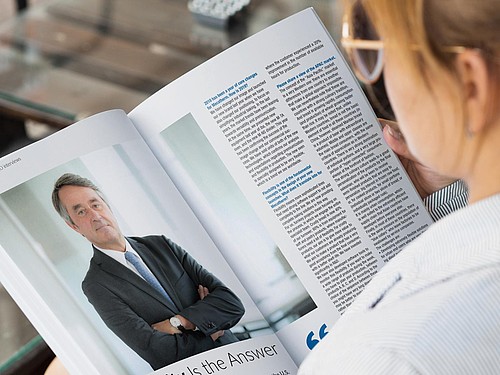Flexibility Is the Answer
Mecatherm officially introduced its new brand and technology to the U.S.market at IBIE. On this occasion, Olivier Sergent, the company’s CEO, shared with us his views about the industry and expertise in the region.
2018 has been a year of core changes for Mecatherm. How is 2019?
We have changed our image and launched our new brand last year when we have also changed our positioning, to focus on simplifying industrial baking. In the last years, the market trends have been leaning towards versatility and premiumization. At the same time, we presented new equipment last year at iba, the new M-TA oven, and the new M-NS divider. This year has been confirming the success of the image change and our commercial success. We have sold units of both of the new technologies, which confirms our analysis and expectations regarding premiumization and flexibility in production. The new oven is specially designed to be very flexible, which is a trend we see worldwide.
Flexibility is one of the fundamental concepts in the design of your new launches. What does it translate into for Mecatherm?
Flexibility means more sophisticated lines that need strong software support to not add complexity to the line. We are now providing complete baking solutions in this way. For us, turnkey projects mean focusing on the process, in which we engage the entire specialist team. Crusty bread is now 40% of our turnover; 60% is from equipment for soft and pastry products, where manufacturers need a lot of flexibility. For crusty products, our aim is to give more value to what our customers are already producing. We aim to make a product that has a very good acceptancy from the final consumer, with a better shelf-life. We have invested significantly in R&D.
We have also developed software tools to monitor this flexibility. If you want to make a wide range of products during the week, you have to plan your production, between products A, B, C, and D. According to the choice of the sequence between these, you might have very long downtimes – it may be better to make A, B, D, and C, rather than alphabetically. The software makes it possible to perform simulations so materials are not wasted for trials. We have implemented this in a factory where the customer experienced a 20% improvement in the number of available hours for production.
How do you characterize the market and its demand for technology solutions?
You will see a very wide range of products everywhere, from in-store bakeries to supermarkets, compared to 15 years ago. The impact is visible with our customers. Flexible lines that will allow producers to be first on the market with the new product are now preferred over very big lines, mono-lines. This is what we are proposing, equipment that can support a wide range of products; personalizations can be made at each production stage, whether it is seeding, flour dusting, injecting, or slicing. If you consider different make-up lines, different baking support, and a wide range of personalization possibilities, then the range of products that can be made on a flexible line is indeed very wide.
What are some of the innovations that you observe?
I wouldn’t focus on a single one but on a trend. People focus on healthy products and strong flavor. Food safety is also a very important aspect. We see more and more single-serving portions and sliced products – this is a strong trend for people on-the-go. Furthermore, the final consumers want to know what they eat so they focus on transparency. This is a strong opportunity for our customers to promote themselves, because, when you buy a product, you want to know who you are buying it from, at the end of the day. The packaging is very important for this.
While fermentation means time, is there a way to make it faster?
I don’t believe in taking shortcuts with time. Bakery products need time. Quality comes from time; you have to pay for it. Time is the most important ingredient in baking and we shouldn’t try to make everything fast. Instead, the baking facility should be just adjusted to the product that requires time. To make a good product, you need care and time.
What are some plans for the future, or innovations that bakers can look forward to?
We will keep on working on flexibility, premiumization, and most importantly, to make the life of the baker simple. The software will increasingly become a key tool for this, because one of the big problems our customers are facing is in hiring technical resources. Our lines have to be easier and easier to operate and to control. I am convinced that medium-sized, flexible lines will be the key in the future for bakery. Customization is the key factor, the baker has to be able to make customized products.
What type of solutions from your portfolio do you expect to be requested in the future?
Flexibility will be key. The challenge used to be price vs. quality; now, there is a third player, I have to be flexible and balance price, variety but with no compromise on quality and flexibility. Not all bakers will be able to do that. Looking at challenges in the production of bread itself; crusty bread is still a reference. If you can bake crusty bread, you can bake everything. This is the most difficult to bake.
Where do you see the industry in the next years?
Frozen still has a big future, definitely. Proximity will be important: sustainability is also a big trend: people will be increasingly reluctant to eat a product that went twice
around the world before reaching their plate. We will see more and more big players coming in addition to new players, medium- sized bakeries and industrials with local operations have fantastic opportunities.
By Catalina Mihu - Asia Pacific Baker & Biscuit - WorldBakers

